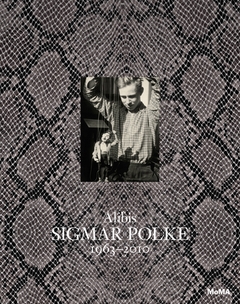
Originally published in the Marina Times San Francisco in May 2014
You can’t exist in a vacuum, you are rooted in time. —Sigmar Polke
Sigmar Polke is primarily known for his paintings. Alibis: Sigmar Polke, recently published by MOMA New York, illustrates the broad scope of the artists’ work which includes film, drawing, performance, photography installation, Xerox and combinations of these mediums creating, for the first time, a complete picture of the artists’ career.
Born in Germany, Polke studied arts at the Dusseldorf Arts Academy where he was profoundly influenced by his teacher, the artist Joseph Beuys. Both artists utilized unconventional materials in their art—in Beuys’ case, felt and fat. Polke mixed elements like arsenic, uranium and meteor dust in his paint out of his interest in alchemy and the human condition in the atomic age. Unseen destructive forces such as toxicity and radiation fascinated Polke, and he covered the canvas with chemicals that are altered by their environment, transforming the appearance of the paintings’ surface over time.
For example, Polke’s The Spirits That Lend Strength Are Invisible III (1988) is a part of the SF MOMA’s permanent collection and contains nickel, silver and meteor granulate to symbolize the new world of the American Continent. A tribute based on a Native American proverb, the pulverized metals in the paint react with sunlight causing a slow coloration change as the painting advances in years. Palmen, also residing at the SF MOMA, is an example of Polke’s more traditional Pop Art stylings combining acrylic Ben Day dots on mattress ticking.
Polke, along with his contemporaries Gerhard Richter and Konrad Fischer, created the movement they called “Capital Realism” as a kind of anti-art that embraces the design approaches in advertising. Their version of pop art included images from newspaper headlines and repeated motifs not commonly associated with fine art.
Through the seventies, Polke traveled throughout the world and created performance and photography pieces inspired by his journeys. When he eventually returned to painting, he merged abstract and figurative imagery to forge a new approach to the medium using everyday subject matter in unusual juxtapositions suggesting inner worlds and introspection.
One of the most influential artists of the postwar generation, Sigmar Polke’s impact is evident in the works of contemporary painters such as David Salle, Julian Schnabel and Richard Prince. Polke’s journals, drawings and photos also appear in this volume providing an intimate glimpse into the artist’s experimental process.